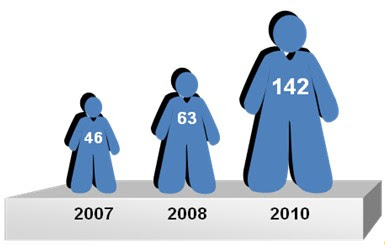Future Chinese online market
E-retailing market has almost reached maturity in developed countries. At the current growth rate, China has the largest internet user base in the not too distant future now (Pingdom, 2010) (figure 1). And online shopping population are continuously growing in China nowadays, reaching at 142 million in 2010 (Alibaba Group Research Centre, 2010) (figure 2). China has put a great deal of emphasis on the development of information technology and has determined that the internet is an important tool for continued economic growth. Thus, the online market in China is growing rapidly and has a strong potential (Alibaba Group Research Centre, 2010).
Figure 1 Six countries in terms of Internet users
(Unit: million)
Figure 2 Online shopping population growth in China
Currently several different formats of e-retailing adopted by companies worldwide are the following.
- Bricks and clicks - established retailers developing a multi-channel strategy from bricks-and-mortar stores integrate the Internet into their businesses (Chaffey et al., 2006). Currently, the most successful online retailer in the world is Tesco.com, where personal shoppers select the customers’ goods in local stores (Chaffey et al., 2006).
- Clicks and mortar - Supported by a physical distribution infrastructure, virtual merchants doing online trade to accommodate consumer demands by trading online. The best-known virtual merchant using this format is Amazon.com, the world’s largest online bookstore (Chaffey et al., 2006).
- Pureplays – “Clicks-only” or virtual retailers are organizations only available online. In reality it is almost impossible for a business to operate online without a point of access to the Internet and warehouses. Therefore, in other words, there are no fixed-location stores for these format retailers (Chaffey et al., 2006). ASOS is the No.1 e-fashion retailers in pureplays (Hitwise, 2010).
- Manufacturers of consumer goods – retailers selling products directly from manufactures to the end consumers, shortening the value chain and/or the supply chain by trading electronically and leading a lower cost (Chaffey et al., 2006).
In Chinese e-retailing market, we can only recall several well-known e-retailers.
- Clicks and mortar – Dangdang.com & joyo (amazon.cn)
- Pureplays – Jingdong (digital products), Taobao.com (shop bots)
- Manufacturers of consumer goods – VANCL.com (Chinese largest independent online own label fashion apparel retailer; available only online)
As we can see, there are almost no “bricks and clicks” in Chinese e-retailing market. Some high-street fashion brands, such as ZARA, H&M, haven’t online shops facing Chinese market. Maybe they don’t think Chinese online market has reached maturity, but the fact is the internet-based electronic commerce environment has developed dramatically in recent Chinese market; the turnover of e-retailing has rocketed into 250 billion RMB last year; and increasing populations are enjoying shopping online. Taobao has begun to expand their market from C2C to B2C, covering 80% market share in the whole e-retailing market, and 20% market share in B2C market. For most consumers, the image of Taobao still stays in the C2C. Thus, it is high time those high street fashion brands should set up their online shops in China.
Therefore, in my point of view, it is a trend that some global high street fashion brands will expand their online market in China in the near future, and the multi-channel retailing will definitely double their profit.


No comments:
Post a Comment